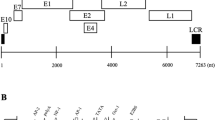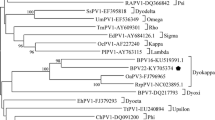Abstract
Bovine papillomavirus type 12 (BPV-12, putative type BAA1) was detected in epithelial papilloma located on the tongue of an infected cow. Then, the whole genome was sequenced, and phylogenetic analysis illustrated that it should be classified as a member of the genus Xipapillomavirus. The viral genome is 7197 base pairs in length and contains five early ORFs (E1, E2, E4, E7 and E8), three late ORFs (L1, L2 and L3), and a long control region that possesses replication regulatory elements. Meanwhile, mRNA of each gene was detected in the papilloma sample. The papilloma was identified as epithelial papilloma by histological and immunohistochemical examination. Based on the genome information and pathological properties, BAA1 was designated as BPV-12 in this study.




Similar content being viewed by others
References
Antonsson A, Hansson BG (2002) Healthy skin of many animal species harbors papillomaviruses which are closely related to their human counterparts. J Virol 76:12537–12542
Apt D, Chong T, Liu Y, Bernard HU (1993) Nuclear factor I and epithelial cell-specific transcription of human papillomavirus type 16. J Virol 67:4455–4463
Apt D, Liu Y, Bernard HU (1994) Cloning and functional analysis of spliced isoforms of human nuclear factor I-X: interference with transcriptional activation by NFI/CTF in a cell-type specific manner. Nucleic Acids Res 22:3825–3833
Bauknecht T, Shi Y (1998) Overexpression of C/EBPbeta represses human papillomavirus type 18 upstream regulatory region activity in HeLa cells by interfering with the binding of TATA-binding protein. J Virol 72:2113–2124
Bernard HU, Burk RD, Chen Z, van Doorslaer K, Hausen H, de Villiers EM (2010) Classification of papillomaviruses (PVs) based on 189 PV types and proposal of taxonomic amendments. Virology 401:70–79
Bernard HU (2005) The clinical importance of the nomenclature, evolution and taxonomy of human papillomaviruses. J Clin Virol 32(Suppl 1):S1–S6
Borzacchiello G, Roperto F (2008) Bovine papillomaviruses, papillomas and cancer in cattle. Vet Res 39:45
Bravo IG, Alonso A (2004) Mucosal human papillomaviruses encode four different E5 proteins whose chemistry and phylogeny correlate with malignant or benign growth. J Virol 78:13613–13626
Campo MS (2002) Animal models of papillomavirus pathogenesis. Virus Res 89:249–261
Chan HM, Smith L, La Thangue NB (2001) Role of LXCXE motif-dependent interactions in the activity of the retinoblastoma protein. Oncogene 20:6152–6163
Claus MP, Lunardi M, Alfieri AF, Ferracin LM, Fungaro MH, Alfieri AA (2008) Identification of unreported putative new bovine papillomavirus types in Brazilian cattle herds. Vet Microbiol 132:396–401
Dahiya A, Gavin MR, Luo RX, Dean DC (2000) Role of the LXCXE binding site in Rb function. Mol Cell Biol 20:6799–6805
de Villiers EM, Fauquet C, Broker TR, Bernard HU, zur Hausen H (2004) Classification of papillomaviruses. Virology 324:17–27
Dean FB, Nelson JR, Giesler TL, Lasken RS (2001) Rapid amplification of plasmid and phage DNA using Phi 29 DNA polymerase and multiply-primed rolling circle amplification. Genome Res 11:1095–1099
Desaintes C, Demeret C (1996) Control of papillomavirus DNA replication and transcription. Semin Cancer Biol 7:339–347
Dick FA, Dyson NJ (2002) Three regions of the pRB pocket domain affect its inactivation by human papillomavirus E7 proteins. J Virol 76:6224–6234
Forslund O, Antonsson A, Nordin P, Stenquist B, Hansson BG (1999) A broad range of human papillomavirus types detected with a general PCR method suitable for analysis of cutaneous tumours and normal skin. J Gen Virol 80(Pt 9):2437–2443
Gloss B, Bernard HU, Seedorf K, Klock G (1987) The upstream regulatory region of the human papilloma virus-16 contains an E2 protein-independent enhancer which is specific for cervical carcinoma cells and regulated by glucocorticoid hormones. EMBO J 6:3735–3743
Groff DE, Lancaster WD (1985) Molecular cloning and nucleotide sequence of deer papillomavirus. J Virol 56:85–91
Hatama S, Ishihara R, Ueda Y, Kanno T, Uchida I (2011) Detection of a novel bovine papillomavirus type 11 (BPV-11) using xipapillomavirus consensus polymerase chain reaction primers. Arch Virol 156:1281–1285
Hatama S, Nobumoto K, Kanno T (2008) Genomic and phylogenetic analysis of two novel bovine papillomaviruses, BPV-9 and BPV-10. J Gen Virol 89:158–163
Hoppe-Seyler F, Butz K, zur Hausen H (1991) Repression of the human papillomavirus type 18 enhancer by the cellular transcription factor Oct-1. J Virol 65:5613–5618
Howley PM, Lowy DR (2007) Papillomaviruses. In: Knipe DM, Howley PM (eds) Fields Virology. Lippincott Williams and Wilkins, Philadelphia, pp 2299–2354
Jackson ME, Pennie WD, McCaffery RE, Smith KT, Grindlay GJ, Campo MS (1991) The B subgroup bovine papillomaviruses lack an identifiable E6 open reading frame. Mol Carcinog 4:382–387
Liu X, Clements A, Zhao K, Marmorstein R (2006) Structure of the human Papillomavirus E7 oncoprotein and its mechanism for inactivation of the retinoblastoma tumor suppressor. J Biol Chem 281:578–586
Lu JZ, Sun YN, Rose RC, Bonnez W, McCance DJ (1993) Two E2 binding sites (E2BS) alone or one E2BS plus an A/T-rich region are minimal requirements for the replication of the human papillomavirus type 11 origin. J Virol 67:7131–7139
Morgan IM, Campo MS (2000) Recent developments in bovine papillomaviruses. Papillomavirus Rep 11:127–132
Morris PJ, Dent CL, Ring CJ, Latchman DS (1993) The octamer binding site in the HPV16 regulatory region produces opposite effects on gene expression in cervical and non-cervical cells. Nucleic Acids Res 21:1019–1023
Narechania A, Terai M, Chen Z, DeSalle R, Burk RD (2004) Lack of the canonical pRB-binding domain in the E7 ORF of artiodactyl papillomaviruses is associated with the development of fibropapillomas. J Gen Virol 85:1243–1250
O’Connor M, Bernard HU (1995) Oct-1 activates the epithelial-specific enhancer of human papillomavirus type 16 via a synergistic interaction with NFI at a conserved composite regulatory element. Virology 207:77–88
Ogawa T, Tomita Y, Okada M, Shinozaki K, Kubonoya H, Kaiho I, Shirasawa H (2004) Broad-spectrum detection of papillomaviruses in bovine teat papillomas and healthy teat skin. J Gen Virol 85:2191–2197
Ogawa T, Tomita Y, Okada M, Shirasawa H (2007) Complete genome and phylogenetic position of bovine papillomavirus type 7. J Gen Virol 88:1934–1938
Parrish CR (2011) Papillomaviridae and Polyomaviridae. In: Maclachlan NJ, Dubovi EJ (eds) Fenner’s veterinary virology. Elsevier, Oxford, pp 213–223
Patel KR, Smith KT, Campo MS (1987) The nucleotide sequence and genome organization of bovine papillomavirus type 4. J Gen Virol 68 (Pt 8):2117–2128
Rector A, Bossart GD, Ghim SJ, Sundberg JP, Jenson AB, Van Ranst M (2004) Characterization of a novel close-to-root papillomavirus from a Florida manatee by using multiply primed rolling-circle amplification: Trichechus manatus latirostris papillomavirus type 1. J Virol 78:12698–12702
Rector A, Tachezy R, Van Ranst M (2004) A sequence-independent strategy for detection and cloning of circular DNA virus genomes by using multiply primed rolling-circle amplification. J Virol 78:4993–4998
Rector A, Tachezy R, Van Doorslaer K, MacNamara T, Burk RD, Sundberg JP, Van Ranst M (2005) Isolation and cloning of a papillomavirus from a North American porcupine by using multiply primed rolling-circle amplification: the Erethizon dorsatum papillomavirus type 1. Virology 331:449–456
Scheffner M, Whitaker NJ (2003) Human papillomavirus-induced carcinogenesis and the ubiquitin-proteasome system. Semin Cancer Biol 13:59–67
Tamura K, Dudley J, Nei M, Kumar S (2007) MEGA4: molecular evolutionary genetics analysis (MEGA) software version 4.0. Mol Biol Evol 24:1596–1599
Tomita Y, Literak I, Ogawa T, Jin Z, Shirasawa H (2007) Complete genomes and phylogenetic positions of bovine papillomavirus type 8 and a variant type from a European bison. Virus Genes 35:243–249
Ustav M, Ustav E, Szymanski P, Stenlund A (1991) Identification of the origin of replication of bovine papillomavirus and characterization of the viral origin recognition factor E1. EMBO J 10:4321–4329
Acknowledgments
This work was partly supported by the Project for Zoonoses Education and Research, University of Miyazaki, and by a grant from Japan Society for the Promotion of Science (No. KAKENHI22780272).
Author information
Authors and Affiliations
Corresponding author
Additional information
W. Zhu and J. Dong contributed equally to this work.
Rights and permissions
About this article
Cite this article
Zhu, W., Dong, J., Shimizu, E. et al. Characterization of novel bovine papillomavirus type 12 (BPV-12) causing epithelial papilloma. Arch Virol 157, 85–91 (2012). https://doi.org/10.1007/s00705-011-1140-7
Received:
Accepted:
Published:
Issue Date:
DOI: https://doi.org/10.1007/s00705-011-1140-7




